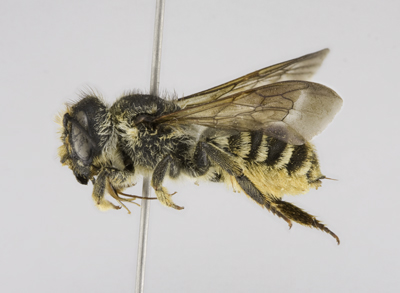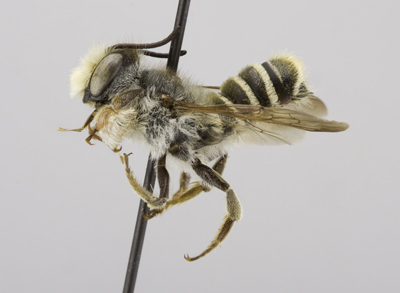
27. Megachile (Sayapis) fidelis Cresson, 1878
Megachile fidelis Female |
Megachile fidelis Male |
Megachile fidelis Cresson, 1878. Trans. Amer. Entomol. Soc. 7: 120 (♀, ♂).
Megachile fidelis concinnula Cockerell, 1899. Entomologist 32: 158 (♀).
Diagnosis.The female of M. fidelis is distinct and can be recognized by conspicuous, spatulate protuberances at each side of the clypeus. The male of M. fidelis can be recognized by the combination of 3-dentate mandibles, T5 with white apical fascia, and the front basitarsus with a brush of dark bristles extending nearly to apex, with boat-shaped dilation mostly bare and polished in apical third and extending at most as far as the middle of 2nd tarsomere. They are most similar to M. mellitarsis and M. pugnata. Males of M. mellitarsis have T5 without white apical fascia, the front basitarsus with boat-shaped dilation elongated apically and extending to apex of 3rd tarsomere, and bright reddish brown tarsi which contrast the black tibiae and femora. Males of M. pugnata have the front basitarsus with brush of short, dark bristles reduced, not extending beyond its basal third, and apical third of boat-shaped dilation entirely covered on the outer side with dense appressed hairs.
FEMALE: Length 11-13 mm.
Head:
Figure M27: Megachile fidelis female mandible |
1) compound eyes slightly convergent below; lateral ocelli slightly nearer eyes than edge of vertex (3:4), 2) clypeus flat above, with a conspicuous, spatulate protuberance at each side, the margin between these excavated, polished and impunctate, with a median carinate spine-like projection, 3) mandible 4-dentate, with an incomplete cutting edge between the 2nd and 3rd teeth (Figure M27), 4) gena slightly broader than compound eye (9:8), 5) punctures fine and very close over entire head, separated medially in apical half of supraclypeal area and on clypeus basally, punctures of clypeus more course and distinctly separated apically, 6) pubescence long and pale yellow over most of head, paler on gena with some hairs short and subappressed along outer edge of eye, pubescence brown on vertex, 7) F1 subequal in length to both the pedicel and F2, remaining flagellomeres quadrate to slightly longer than broad, apical flagellomere longer than broad (3.5:2).
Mesosoma:
1) pubescence yellowish, short and thin, hardly concealing surface, more elongate on pleura, longer brownish hairs on mesoscutum medially and scutellum, with appressed/subappressed pale hairs, pubescence more dense and plumose adjacent to tegula and on pronotal lobe, 2) punctures fine and very close, almost rugose, over most of dorsal surface, pleura finely and closely punctate, propodeum with fine, shallow punctures which are separated by about 1 pd, triangle dull and impunctate, 3) basitarsi slightly shorter and slightly narrower than their tibiae, spurs reddish-brown, 4) tegula reddish-brown, almost entirely impunctate in apical half, 5) wings transparent, darker apically, the veins reddish-brown.
Metasoma:
1) narrow and elongate, somewhat parallel-sided; T2-T4 deeply grooved basally with a distinct carinate rim, rather deeply depressed apically, T6 more or less rounded in dorsal aspect, in profile slightly convex due to abrupt, shelf-like apical lip; punctures fine and very close over most of the terga, but becoming slightly more coarse on T5; T1-T5 with conspicuous entire dense pale yellowish apical fasciae, discal pubescence somewhat brownish medially on T2-T5, becoming yellowish laterally, T6 entirely covered with pale yellowish tomentum, with no dark admixture, 2) S6 rounded, uniformly covered with scopal hairs, scopa entirely pale yellow; punctures coarse and close, becoming more wide spaced on apical sterna.
MALE: Length 10-12 mm.
Head:
1) compound eyes very slightly convergent below; lateral ocelli slightly nearer edge of vertex than eyes (5:6), 2) clypeal margin impunctate with a broad shallow median emargination, 3) mandible 3-dentate, lower process acute, submedian in position, 4) gena subequal to compound eye in width, with a large, bare concavity at lower angle, the lower margin of which is produced into a flat triangular spine, 5) punctures fine and close over most of head, but more distinctly separated on vertex laterally, shallow on gena, 6) pubescence white to pale yellow on most of head, but vertex usually with some intermixture of brown hairs, 7) F1 broader than long (2:1.5) and subequal in length to pedicel, following flagellomeres considerably longer than broad (3:2), the apical flagellomere elongate (4.5:2) and slightly flattened, antennae reddish beneath.
Mesosoma:
1) pubescence entirely white to pale yellow; front basitarsal scale fringed for entire length on inner anterior margin with short black pubescence, the posterior fringe white, tipped with brown beneath, 2) punctures fine and close over most of mesoscutum, shallower on scutellum, propodeum smooth and sparsely punctate, triangle impunctate, 3) front coxa bare and shining anteriorly, with a pair of stout red bristles in front of the slender, moderately long spine; front femur slender; front tarsus dilated and flattened, yellowish except for the dark apical tarsomere, tarsomeres 2 and 3 each with a dark spot ventrally, front basitarsus produced anteriorly into a very large, reddish-brown, and deeply concave scale that is produced apically nearly to the tip of tarsomere 2, mid and hind basitarsi slender and relatively long, spurs yellow, 4) tegula reddish-brown, shiny and nearly impunctate, 5) wings transparent, darker apically, the veins reddish-brown.
Metasoma:
1) parallel-sided, T3-T5 depressed apically, margin impunctate and hyaline, T3-T5 with basal depressions with carinate rims, T6 basally horizontal in orientation, impunctate with carinate rim, remaining face of tergum vertical in orientation, carina of T6 with a small but usually deep, circular median emargination, more or less crenulate laterally, with a median pit above the emargination, apical margin of T6 with teeth hardly evident, T7 rounded apically; punctures fine and close on basal terga, becoming more distinct and deep but still rather close on apical terga, minute and densely crowded on T6; pubescence white to pale yellow on T1 and most of T2, T3-T6 with intermixtures of black and whitish or yellowish discal pubescence; T2-T5 with entire, white or yellowish, apical fasciae, T4-T5 with basal tomentum arising from under carina, 2) S1-S4 exposed, S2-S4 with wide hyaline apical rims, S4 slightly emarginate medially; discs shiny with rather fine and close punctures, sparsely pale pubescent on discs of sterna, with elongate pale hairs along apical rims.
Genitalia: Figure G27.
|
Figure G27: Megachile fidelis genitalia |
Discussion:
This distinct species accepts trap-nests (Barthell et al. 1998; Frankie et al. 1998) (Table 1). Although probably polylectic, this species is commonly collected on Helianthus flowers (Hurd et al. 1980).
Distribution:
Southern BC (see Map 27).
|
Map 27: Canadian distribution of Megachile fidelis |




